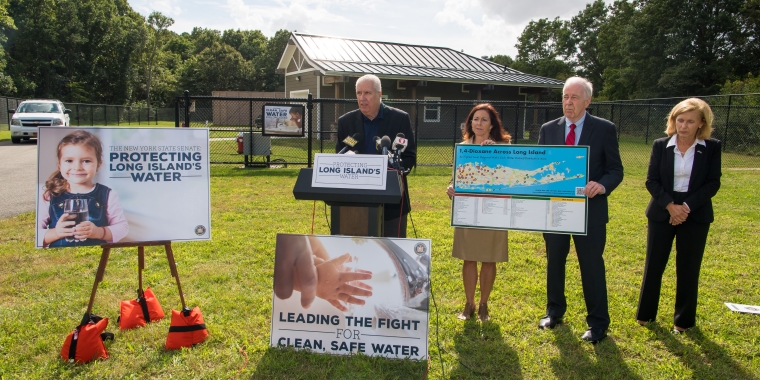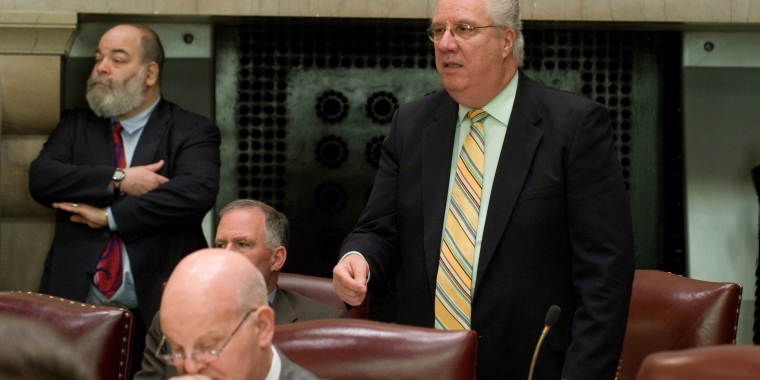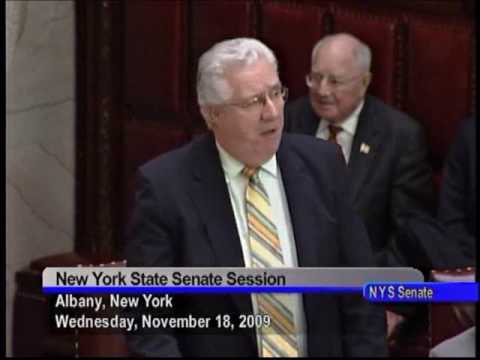
SENATORS CALL ON CUOMO ADMINISTRATION TO STOP DELAYING AND FAST-TRACK NEW DRINKING WATER SAFEGUARDS
September 25, 2018

Senators Elaine Phillips, Kemp Hannon, and Carl L. Marcellino today demanded that Governor Cuomo and the state departments of Health and Environmental Conservation take immediate steps necessary to protect New York’s drinking water from potentially harmful chemicals. The Senators released a four-part action plan to restart the stalled process required to set state standards for 1,4-dioxane, PFOA, and PFOS, ensure local governments have access to the funds needed to remove drinking water contaminants, and improve public notification about emerging health threats.
Senator Marcellino said, “The Governor needs to protect our residents from chemicals in their drinking water. These are known contaminants with known risks. There cannot be any more delays in setting the most protective standards. We must do everything we can to ensure that our residents have access to the safest and cleanest water. We have a responsibility to protect the safety of every resident in New York State. No one should ever be put in jeopardy by tainted water.”
The Senators called upon the Cuomo administration to take four necessary steps that will help communities on Long Island and throughout the state protect their water quality and prevent contaminants from affecting public health:
1. Hold Drinking Water Quality Council Meetings
The Drinking Water Quality Council was created by the Senate and included as part of the 2017-18 state budget to make recommendations to the Department of Health ensuring the safety of potable water. It is one of the actions taken following investigations in several Long Island communities, Hoosick Falls and Petersburgh in Rensselaer County, Newburgh in Orange County, and other municipalities across the state where the potentially harmful chemicals 1,4-dioxane, PFOA, and PFOS were detected in drinking water supplies.
While three meetings were held shortly after Council members were appointed in September 2017, a March 2018 meeting was cancelled and still has not been rescheduled. No other meetings have taken place over the past seven months and recommendations on safety thresholds are due early this October.
2. Set New Recommended Levels for Drinking Water Safety
New York State needs to establish state standards to protect the public from emerging contaminants because the federal government has not yet done so. Despite an announcement from Governor Cuomo in February 2017 touting the importance of setting a drinking water standard for 1,4-dioxane, and outreach from the Senators urging DOH and DEC to quickly adopt state safeguards, the state has still not acted 18 months later.
3. Support Infrastructure Investment to Prevent Water Contamination
As part of the 2017-18 state budget, the Senate successfully secured a historic $2.5 billion investment in funding to support clean water infrastructure. Projects that would protect water supplies from 1,4-dioxane, PFOA, and PFOS are eligible to compete for this funding. However, given the absence of any specific state standards for these contaminants, water districts may be unaware that they need to remediate and may be at a disadvantage in the application scoring process until new standards are established.
4. Sign a Senate Bill Improving Public Awareness of Dangerous Contaminants
Earlier this year, both houses of the Legislature passed a bill (S6655) to improve public awareness of harmful contaminants in the environment. It requires DOH to post information on its website about emerging contaminant notifications levels and create educational materials so that the information is easily accessible to residents and public water system managers. Currently, finding such information can be difficult and this bill would make it easier to find these important details with an accessible link on the Department's website and other public information materials. The Governor has not yet acted on the bill to make it law.
Adrienne Esposito, Executive Director of Citizens Campaign for the Environment, said, “The science is clear, the problem is intensifying; immediate action for drinking water standards for these contaminates is a matter of urgency. Every week we delay puts the public at risk. In CCE’s own independent testing, 23 out of 30 common household products contained 1,4 dioxane, which contributes to the drinking water problem.”
The Senate has been leading the charge to address drinking water quality by reaching out to impacted communities, providing significant resources, and implementing legislative initiatives that protect public health and the environment. Hearings led by Senators O’Mara and Hannon held in 2016 led to an extensive report on Water Quality and Contamination in early 2017, followed by the adoption of a state budget with the largest single investment in clean water infrastructure in the state’s history. Senate measures committing additional support to help Hoosick Falls address a legacy of contamination in that community became law, and a bill to help protect the Petersburgh water supply are among other measures that the Senate will continue to pursue to protect public health and the environment.
###
Share this Article or Press Release
Newsroom
Go to NewsroomStatement by Senator Marcellino on Deficit Reduction Plan
November 20, 2009



Senator Marcellino addresses New York's New Tough DWI Law
November 18, 2009
